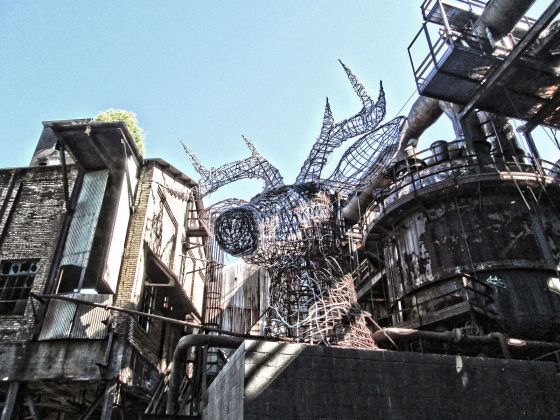PHLF Lecture: Recycling Space
PHLF Lecture: Recycling Space – New Architecture in Old Places

This text was excerpted from a May 7, 2015 lecture hosted in Wilkinsburg by the Pittsburgh History & Landmarks Foundation.
I’m fortunate to have worked at Fisher Architecture with a great group of talented people. Without their assistance, my efforts to assist in the creation of a new approach to architecture in Pittsburgh would be for naught. Although I’m going to talk here about form and experience, many other factors are also important in building design. Designing green is important: I’m LEED AP and a bigger supporter of the Living Building Challenge and Passive House standards. Designing affordably is important. Rigorous drawing sets are important. So are strong engineering strategies.

That being said, I’ve been thinking about the following idea I presented in my previous post, Reimagining Pittsburgh: Only by carefully studying Pittsburgh’s existing context may an architect design new forms for it. I’m now of the opinion that that not only is context important when you are coming up with the project ideas, it is also important as you design and build the project!

Here’s an analogy: There are different ways to take action. There’s the kind of person who (carefully or not) studies a situation where change needs to occur, forms a strong opinion upon it, and then acts, dragging everyone along behind them. This kind of person is a flag carrier. You often see him portrayed on TV, especially in military roles. Think of George C Scott. Certain designers are like this. They impose solutions on their sites like generals. Howard Roark, the protagonist of Ayn Rand’s novel about an architect, would be a great example.
He’s a genius after all. The rest of the world should just get out of the way and let him build… However, these projects tend to meet with failure. Either the projects don’t get built because they don’t get buy-in from the client and the community, or if they are constructed they tend to not respond to the people they are meant to serve.
Times have changed. We are no longer so absolute in our intentions or beliefs as we were when Ayn Rand wrote the Fountainhead, if we ever were. The meaning of an architect’s creation always exceeds his intentions, whether he is aware of it or not. The best lecture I ever attended was a convocation speech in which Dartmouth College president, John Kemeny, spoke of the danger of leaders posing deceptively simple solutions to complex problems.

Design is the same way. The thought that an architect comes up with a concept and simply applies it onto a site is no longer relevant, if it ever was. Architecture that does not respond flexibly to its surroundings tends to be very weak: We do not create the world as we go along, we respond to it. Form is something we end with as the final articulation of a deeper logic.
Then there is a second sort of leader. This person listens carefully to everyone’s point of view and negotiates his way carefully toward a solution for the situation he faces, trying to do the right thing by listening very carefully, providing a hierarchy of solutions to the problems he faces, veering and swerving with his process as he proceeds. The cost of the project is too high. Adjust! The forms don’t respond to the client’s desires. Adjust! So we are talking here about evolution, not revolution.
This is not “parti” design, for the architect readers. It is an architecture of “strategies”. This kind of leadership is often messy. Yet architects need to be open to the complications of the world we live in. The world is messy and complex. Deriving a simple architectural solution from all this messiness is exceedingly difficult. As Raphael Vignoli, the architect of our convention center once said, it’s easy to represent complexity with complexity. What is truly a challenge is to represent complexity with simplicity…
New buildings will be constructed. And in my opinion these building should reflect their times. My thought is that copying the look of past buildings shows those past buildings no respect, as the copies tend to be poor. Times change, and so do our needs and our methods of construction.
Yet preserving our history is important. Although the old, it is said, must make way for the new, the city is richer if it’s history is preserved. For one thing, our preserved history is all that ties us to the past other than our memories. And our past is part of us. For another old buildings are often beautiful, and possess value as art.

This is a palimpsest (from the Greek, palimpsestos, meaning scraped again). A palimpsest is a written document on which partially erased previous texts are still visible. One fascinating element of a palimpsest is that it contains a record of its own history. In other words, you can say that first one thing happened and then another. The city is like a palimpsest in that it too can be read as a series of layers.
The image to the right is also a palimpsest. The welded wire mesh “Pittsburgh” sign in my design is affixed to the cables of a new suspension arch in our design for the West End Bridge Competition. The arch, which supports a proposed pedestrian walkway and a bike path, marks the western edge of the city. The screen celebrates our city as football fans walk from downtown to the stadium even as the projected letters tattoo automobiles and pedestrians on the bridge. Legible against the dark slopes, the letters are defined not by the presence of the screens, but rather by their absence. The letters show that the city is defined not by its form but by what is left when the form has gone away, namely our people.





